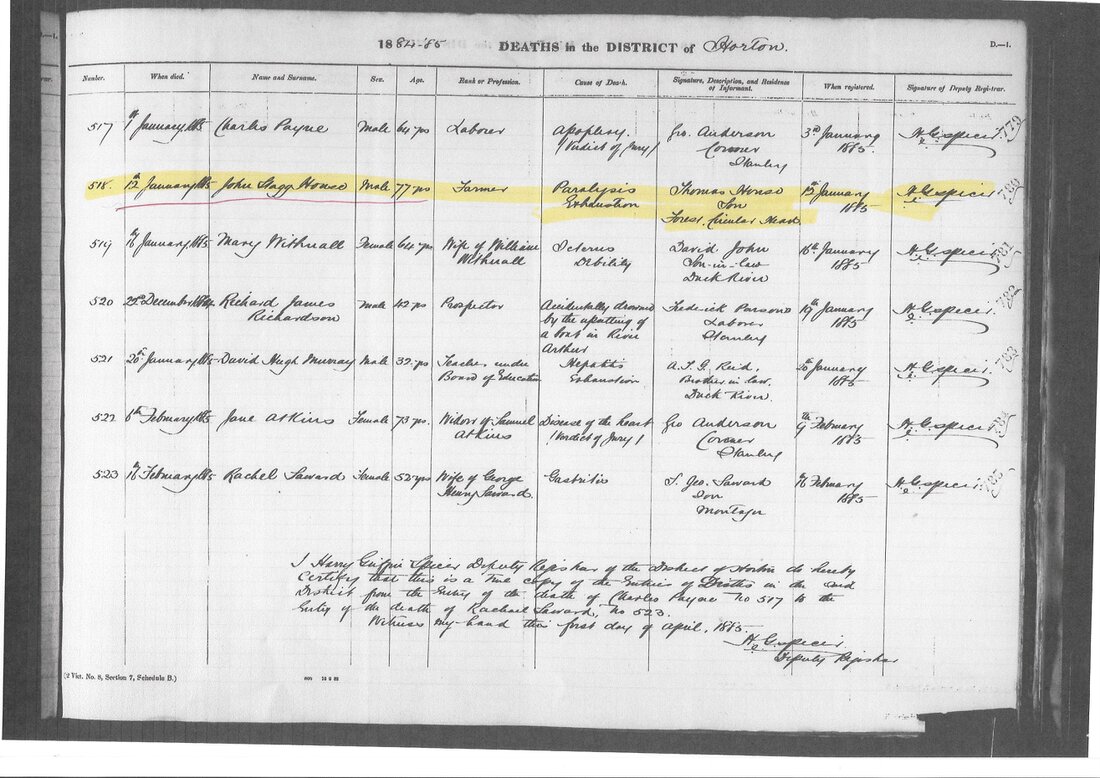John Stagg HOUSE (1807-1885) and Eliza TURNER (1808-1882)
Family Stories > 6th GENERATION
John Stagg House (1807 - 1885)
Spouse : Eliza Turner (1808 - 1882)
John Stagg House and Eliza Turner were my 3rd Paternal Great-Grandparents - 6th Generation
1. Nola Irene Warren
2. .... George Ernest Edward Warren & Iris Ella Ford
3. .... .... Leonard Leslie Warren & Burdett Launder
4. .... .... .... Roberts Launder & Mary Burdett Salisbury
5. .... .... .... .... Richard Burdett Salisbury & Susan House
6. .... .... .... .... .... John Stagg House & Eliza Turner
JOHN STAGG HOUSE Birth 1807, April 25 at Frampton Cotterell, Gloucestershire, UK Baptised 1807, April 30 at Frampton Cotterell, Gloucestershire, UK Father Thomas House (1782 - 1848) Mother Sarah Stagg (1784 - 1857) Siblings 1. Jonathan House (1770 - ....) 2. Thomas House (1772 - C 1773) 3. Ann House (1774 - ....) Spouse Thomas Burcombe 4. Susanna House (1775 - ....) Spouse William Gibbs 5. Henrietta House (1777 - ....) Spouse George Wollen 6. Thomas House (1782 - 1848) Spouse Sarah Stagg 7. Mary House (1786 - ....) 8. James House (1788 - .... 9. Frances House (1790 - ....) Marriage 1830, October 16 at Frampton Cotterell, Gloucestershire, UK Spouse Eliza TurnerResidences 1841 - Chipping Sodbury, Frampton Cotterell, Gloucestershire, UK 1849 - Circular Head, Tasmania 1856 - Forest, Tasmania Occupations 1841 - Agricultural Labourer, Chipping Sodbury, Frampton Cotterell, Gloucestershire, UK 1849 - Farmer, Circular Head, Tasmania Emigration 1841 - Departed Bristol as Bounty passengers on board "Ward Chapman", leaving on August 24, 1841, arriving into Melbourne, Victoria on December 16, 1841 Death 1885, January 12 at Stanley, Tasmania Age at Death 77 years Burial Old Pioneers' Cemetery, Stanley, Tasmania Children 1. Ellen Stagg House Born 1831, May 29 at Frampton Cotterell, Gloucestershire, UK Father John Stagg House Mother Eliza Turner Marriage 1859 in Victoria Spouse John George Louden Death 1875, January 19 at Dunedin, Otago, New Zealand Age at Death 44 years 2. Susan House Born 1833, Circular Head, Stanley, Tasmania Father John Stagg House Mother Eliza Turner Marriage 1850, Stanley, Tasmania Spouse Richard Burdett Salisbury Death 1876, October 16 at Swan Street, Richmond, Victoria Age at Death 43 years Refer to web-page for Richard Burdett Salisbury and Susan House 3. Hester House Born 1836, March 27 at Frampton Cotterell, Gloucestershire, UK Father John Stagg House Mother Eliza Turner Marriage 1857, January 7 in Horton, Tasmania Spouse Thomas Carroll Death 1919, September 24 at Wynyard, Tasmania Age at Death 83 years Father John Stagg House Mother Eliza Turner Death 1853, December 17 at Circular Head, Tasmania Age at Death 14 years Born 1842, January 15 in Victoria Father John Stagg House Mother Eliza Turner Spouse Maria Ellen Bridley (1849 - 1895) Death 1923, March 31 at Forest, Tasmania Age at Death 81 years 6. Elizabeth House Born 1844, August 17 at Horton, Tasmania Father John Stagg House Mother Eliza Turner Spouse James Ferguson Boys Death 1929, July 26 at Stanley, Tasmania Age at Death 85 years 7. Thomas Stagg House Born 1847, June 21 in Horton, Tasmania Father John Stagg House Mother Eliza Turner Spouse Leah Jane Latimer Death 1923, December 13 at Forest, Tasmania Age at Death 76 years 8. Matilda Eliza House Born 1849, October 25 in Horton, Tasmania Father John Stagg House Mother Eliza Turner Marriage 1870, August 17 in Tasmania Spouse Henry Thorp (1848 - ....) Age at Death 50 years 9. Anne Maria House Born 1851. September 30 in Burnie, Tasmania Father John Stagg House Mother Eliza Turner Spouse George Thorp (.... - 1869) Death 1931, September 21 at Forest, Tasmania Age at Death 80 years _____________________________________________________ ELIZA TURNER Birth 1808, January 21 at Frampton Cotterell, Gloucestershire, UK Father Robert Turner (1776 - 1826) Mother Mary Mills (1774 - ....) Siblings 1. Ann Turner (1793 - 1808) 2. Lucy Turner (1796 - 1856) 3. Hannah Turner (1798 - ....) 4. Robert Turner (1800 - ....) 5. George Turner (1803 - 1807) 6. Susannah Turner (1805- 1879) 7. Elizabeth Turner (1807 - ....) 8. Eliza Turner 1808 - 1882) 9. George Turner (1810 - ....) Marriage 1830, October 16 at Frampton Cotterell, Gloucestershire, UK Spouse John Stagg House Death 1882, July 21 in Stanley, Tasmania Age at Death 74 years Burial Old Pioneers' Cemetery, Stanley, Tasmania |
1807 - Birth John Stagg House
Baby John was born on April 25 in 1807 and 'received into the church' on April 30th at St. Peter's Church, Frampton Cotterell, Gloucestershire

1807 - Baptism Register for 1807
Transcription -
1808 - Birth of Eliza TurnerName John Stagg HouseGender MaleBaptism Age 0Event Type BaptismBirth Date 25 Apr. 1807Baptism Date 30 Apr. 1807Baptism Place Frampton Cotterell, St Peter, Gloucestershire, EnglandRegister Type Parish RegisterFather Thomas HouseMother Sarah House (late Stagg, spinster)
Eliza burner was born on January 21 in 1808 in Frampton Cotterell, Gloucestershire and was baptised on March 15 in that year in the Parish of North Cerney, Gloucestershire.
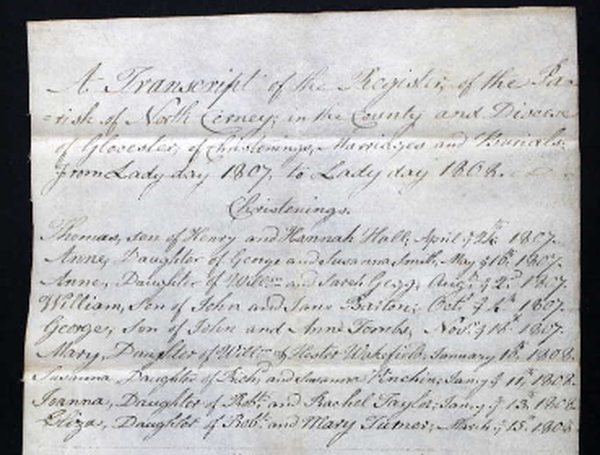
1808 - Baptism Register
Transcription -
Name Eliza TurnerEvent Type BaptismBaptism Date 15 Mar. 1808Baptism Place North Cerney, Gloucestershire, EnglandParish as it Appears North CerneyFather Robt. TurnerMother Mary Turner
1830 - Marriage
John Stagg House married Eliza Turner after banns on the 15th day of October, 1830. John signed the marriage register, whilst Eliza signed with a mark. Witnesses to the marriage were Vernon Turner and Jacob Huggins.
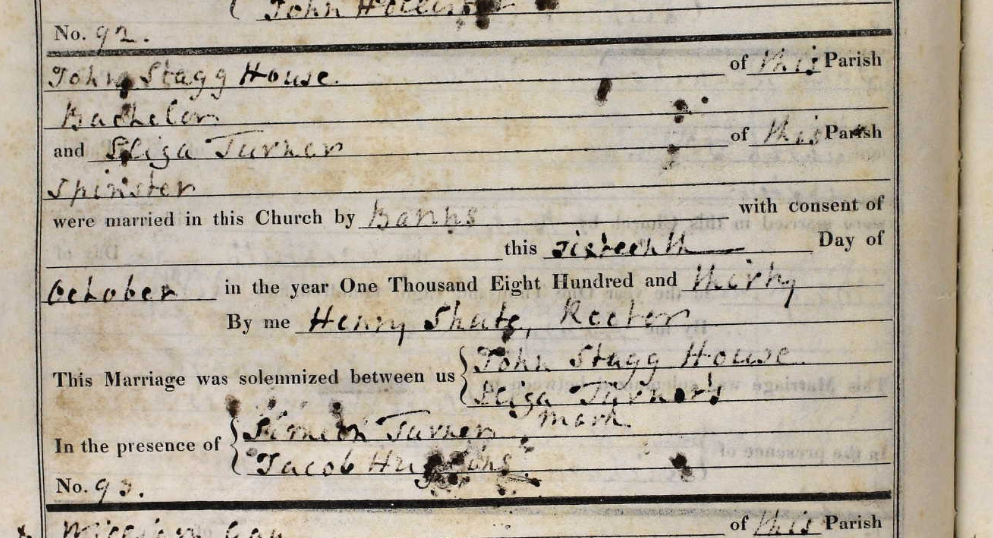
1830 - Marriage Register
1841 Census
The 1841 Census showed the family of John and Eliza and 4 children (Ellen, 10, Susannah, 7, Esther, 5, and John 2) in Chipping Sodbury in Frampton Cotterell. John was working as an agricultural labourer.
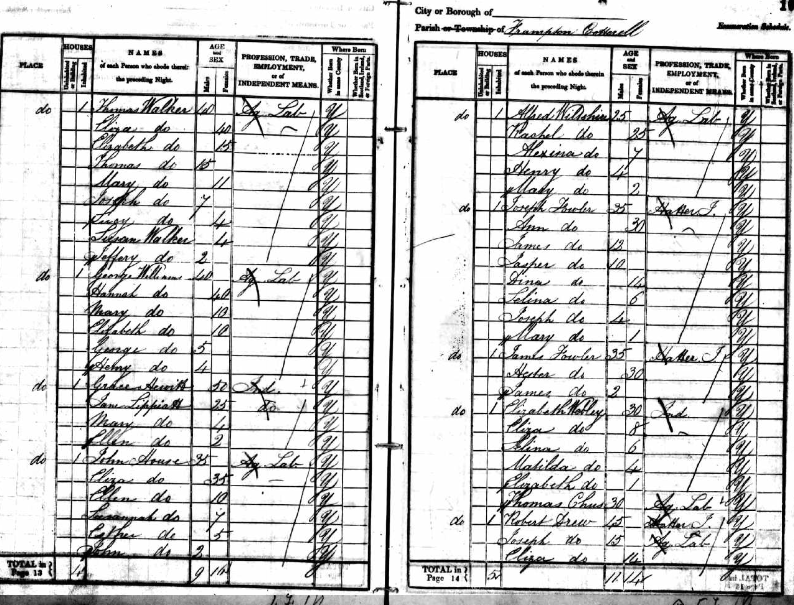
Emigration to Australia
Later in 1841, on August 21, John and Eliza pregnant with her 5th child and their family boarded the ship 'Ward Chapman' bound for Australia. John gave his details, including the fact that he could read and write and he gave his occupation as Farm Servant. Eliza could neither read nor write and her occupation was stated as House Servant. The fare cost £19 per adult, £10 for each of the older child and £5 for each of younger children. Two of John's brothers would follow them to Australia in 1848.
The voyage took 100 days during which time, many difficulties were faced by the families on board. After the ship sailed, it was discovered there was insufficient tablespoons, knives, forks, teaspoons, and pannicans, hook pots, water pails, tubs and mess tins. There was also no coffee mill, no pepper or any other condiments, no hand brushes to sweep out the berths, no charcoal for the stoves, and no cattle medicines. There was also no cook! One of the emigrants had to be appointed to be the cook.
There had been planned to have sufficient water to last them 6 months, but it was discovered that many of the water casks were empty or almost empty. Consequently, there was only enough water to last 14 weeks.
Tinned food was a new concept in the experimental stage of production. But the ship had taken on board a large consignment of tinned food, with many of the seals imperfect so much of the food was spoiled.
The beef and pork had a bad smell and the quality was poor. Flour and oatmeal were sourish. There were two different kinds of peas - one sort took longer to cook. These caused colic and inflammation of the bowel. Sugar was in short supply and by December 3, all the tea was gone. The coffee was rotten. There was no butter or fat which meant the fish was inedible, so some passengers would go without meals.
The Captain, the ship's surgeon, the 1st, 2nd, and 3rd mate were overwhelmed by the number of sick passengers. It became necessary to employ 8 passengers - one to ask as school master for the children, and the rest to help as hospital assistants.
Before the ship rounded the Cape of Good Hope, there were scores of sick children and adults, particularly among the steerage passengers. It seems that the preserved soup had become contaminated by acids formed on the inner surface of some of the tins. The whole food and water situation on board was disastrous. Women and children suffered from bowel disorders, 19 children died from poisoning from the tinned food and 2 adult males died on tuberculosis during the voyage.
Arrival into Melbourne
Eventually, the ship arrived at the small rough frontier township of Melbourne on December 6, 1841. The voyage took just over 100 days. From there the ship travelled to Port Phillip Bay, which took almost two weeks. As they made their way slowly up the river, numbers of stark naked Aborigines jumped around slapping their rumps at them.
1841 - Birth of Jonathan House
Shortly after their arrival, Eliza gave birth on January 5, 1842 to their fifth child, whom they named Jonathan. He was born in Melbourne.
To Stanley, Tasmania!
Sometime between their arrival into Melbourne in 1841 and 1844, John, Eliza and their children travelled to Tasmania and decided to settle in the tiny town of Stanley.
In 1798, Matthew Flinders and George Bass circumnavigated Tasmania, having suspected that the land mass was an island. On this journey they sited the cliffy, round lump, in form much resembling a Christmas cake. They called it ‘Circular Head’ and it wasn't until the 1850's that it started to be called The Nut. Circular Head has since been used to describe the whole area. During the 29 years after Bass and Flinders sailed by, Circular Head was the territory of sealers. Many of these were run-away convicts living on the islands of Bass Strait and they had a reputation for being rough and lawless.
Having heard of the agricultural successes this newly discovered part of the world was providing, a group of London based merchants, businessmen and politicians established the Van Diemen’s Land Company (VDL Co.) in 1824. They hoped to make a fortune from fine merino wool on a large scale. In 1826 they were granted a huge tract of unsettled land in the mainly forested remote north-west. In 1827 a sheltered port was opened below The Nut to facilitate the landing of stud livestock, implements, craftsmen, labourers and assigned convicts. Company employed surveyors deemed the area to be ideal for raising merino sheep. This wasn’t exactly true. The VDL Co. was a failure as a major wool supplier. Other ventures such as breeding of stud horses, cattle grazing, and a deer park did little to alleviate the financial problems experienced by the company.
In the 1840’s assigned convicts were withdrawn from service. The company turned it’s attention to the sale and lease of its holdings. They contracted John Lee Archer to design a town in 1842. Stanley as we know it started with the first gazetted street plan of Stanley drawn up by John Lee Archer, renowned architect and civil engineer and recently appointed police magistrate, in August 1843. John Lee Archer prepared a second town plan in 1848 when the population of Stanley was listed as 127 men, 41 women and 65 children. At that time Stanley had 20 shops and stores, an Anglican Church, parsonage, school and police office.
It was named Stanley after Lord Stanley, British Secretary of State for the Colonies in the 1840s. Leasing blocks of land by the VDL Company began as soon as Archer had finished his survey but it was not until 1851 that the first blocks of land were sold to independent settlers.
1844 - Birth of Elizabeth House
Baby Elizabeth was born in Horton, a district of Tasmania on August 17, 1844
1847 - Birth of Thomas Stagg House
Born in the middle of winter on June 21, 1847 in Horton.
1849 - Birth of Matilda Eliza House
Born on October 25, 1849 in Stanley.
1850 - Justice of the Peace and Encounter with Convict Bradley
John Stagg House was a Justice of the Peace. In 1850, Justice House sentenced a man named Bradley to three months imprisonment for petty theft. Bradley was an ex-inmate of the Port Arthur Penal Establishment. Upon his release,he vowed to get even with all who had wronged him and he struck up an acquaintance with another convict, a cook in military barracks, named O'Connor,who desperately wanted to get to the mainland of Australia and join the gold rush.
1851 - Birth of Ann Maria House
Born 1851 on September 30 at Stanley.
1853 - Horrible Murder at Circular Head
Bradley, the man John House had sentenced to three months in jail back in 1850, helped O'Connor escape and got a change of clothes. O'Connor agreed to join Bradley in going to Stagg farm to settle accounts with John House and steal money to get them to Victoria. Along the way, they came upon the hut of a ticket-of-leave convict - One-Eyed Smith, who agreed to show them the way to Stagg Farm, after being threatened at gun pointJonathan House was lighting the kitchen fire at dawn when he saw the two men approaching, trying to conceal their muskets behind the unfortunate Smith. He woke his father, John House, but before they could find a gun and some clothes, the two ruffians had entered the house. John House, clad in only a night gown and cap escaped through a window and ran towards some nearby scrub. O'Connor saw him and fired, superficially wounding John House in the thigh. House made it to his nearest neighbour, where he borrowed some clothes and a horse and rode to Stanley to seek assistance.In the meantime, the villains had assembled the family and hired hands in the kitchen, threatening them on the belief that substantial amounts of money were hidden in the house. Among them were House's eldest daughter, Ellen, and her fiance, a young carriage painter named Phillips. When Bradley refused to shoot them, O'Connor pointed his gun towards Phillip's head. As he was pulling the trigger, Ellen House dashed forward and took the full charge in her body and fell to the floor gravely wounded. She eventually recovered but was in poor health for the rest of her life. The outlaws quickly withdrew taking Smith with them.In response to the alarm that John House raised, a small military attachment and some special constables were mustered and began to trail the two gunmen. O'Connor was still hopeful of stealing sufficient money to make a fresh start in Victoria when he remembered that the mailman, Paddy the Tinker, would be carrying £2,000 in his bag to Stanley for the VDL Company to pay for purchases. The mail was carried on foot as the track was too poor even for pack horses. They made camp and waited and soon after 10 pm the diminutive mail carrier came into sight. He saw the men by the campfire beckoning him to join them for a cup of tea and cautiously approached to within a few yards when he saw the muskets in the firelight. He ran with O'Connor following shouting threats of murder. He fired hitting Paddy in the left arm. Faint from loss of blood, Paddy scrambled onto the foreshore, throwing the mailbag into a crevice in the rocks. O'Connor gave up the chase and did not see that the bag had been tossed aside.Early the next morning, Paddy staggered into the military camp with the news of the assault and information that the bandits were heading to Table Cape.At 11 am the outlaws arrived at Alexandria, hid their belongings in a stable, and calmly walked into Matthias Alexander's Wynyard Arms and had a few drinks with Robert Wigmore who did not know that they were outlaws or Smith was a hostage. Inquiring about passage to Victoria they were told to go down to the landing stage where Captain Jones was loading his schooner 'Dove' heading to Port Albert on the Gippsland coast of Victoria. Not realising the danger, Jones agreed to give them passage and they wandered back to the inn where they had their first good meal in two days. Suddenly one of the local residents came to the door and shouted to Alexander that the police were coming. Bradley and O'Connor scrambled to their feet and rushed out the back door to the stable to get their guns. In the process, O'Connor knocked Robert Wigmore's small daughter off her chair spilling her cup of tea. He apologised and gave her two shillings.Exchanging gunfire with the pursuers, the outlaws made their way through the scrub to the small jetty, while One-Eyed Smith finished his meal in the company of Wigmore, glad to be rid of his captors. Jumping on board, the villains ordered Jones to set sail, Bradley aiming his musket at the captain and O'Connor crouching under the taffrail covering the crew.About three miles out into Bass Strait, Captain Jones unsuccessfully tried to catch Bradley off guard, only to have his finger blown off as punishment and a warning. Twenty four hours later they arrived on the South Gippsland coast and the outlaws put ashore and headed for Melbourne.Along the way, they murdered a young ploughman and were caught by a detachment of troopers at Caulfield after a fierce gun battle. They were tried for murder and armed robbery in Melbourne and hanged at Pentridge Stockade.Captain Jones returned to a hero's welcome by the settlers and continued to sail the 'Dove' until his retirement in the mid 1860'sSource: "The Stagg Farm Incident : Murder, Home Invasion, and Kidnapping in Colonial Tasmania" Peter Blackwell, Ph.D. Brown University '88 (Rhode Island) and Mark Blackwell, B.Com. B.D. (Euroa, Victoria, Australia.http://www.postcolonialweb.org/australia/blackwell/blackwell8.html
Of course, this event was widely reported in the local newspapers. Interestingly, there are a few differences between the above description and the newspapers' reports, the least of which the name of the schooner in which they traversed Bass Strait. Some of the reports included "many diabolical outrages in different parts of the colony". These included the shooting near Brighton of a ploughman and the theft of two plough horses as well as the shooting of a gardener near Kilmore. And during the final exchange of gunfire, the shooting of a policeman.
The two men where finally hanged on the 24th September, 1853 in front of the Melbourne goal. O'Connor was 23 years of age and Bradley 21.
The following is just one of the newspaper reports of the day -
1853 - Inquest into the Death of Alfred PhillipsAn occurrence unparalleled in the history of this thriving settlement, occurred on the morning of Wednesday, the 14th instant. It appears that on the previous evening, two men named Bradley and O'Connor, (pass holders) - (which means convicts given their tickets of leave) - the former in the service of Mr. George Kay, and the latter in that of James Gibson, Esq., Police Magistrate, absconded from their respective services and proceeded to the house of a settler named Spinks, where they "bailed up" the whole of the inmates,irrespective even of children.Having obtained a double barrelled gun and ammunition, their next essay was at a Mr. Staines', where they arrived between three and four o'clock in the morning. Having roused the people there, they demanded something to eat, when meat and tea where supplied them.After remaining smoking upwards of an hour, they pressed a free man named Smith to accompany them, having previously bound Staines and his servant hand and foot.They went thence to the residence of Mr. John House, situated in "the forest", where they accosted a man named Hendrick, in Mr. House's employ, as to the number of men on his premises. This was about 6 o'clock. Having demanded admittance, a little boy about 6 years old opened the door, and was ordered back by the marauders. A young man named Alfred Phillips, having presented himself, was urged, together with Hendrick, to show them to Mr. House's bedroom, but on passing an apartment occupied by the female portion of the family, they rudely pushed in, and they were bound together by Smith. It appears that at this time, one of the fellows had gone to the front of the house, when Mr. House, upon the alarm being given, having effected his escape through a window, was fired at, but happily without sustaining any injury.The other ruffians were, meanwhile, standing over Phillips and Hendrick, and upon hearing of the failure of the attempt on Mr. House's life, one of them, supposed to be O'Connor, mercilessly discharged both barrels at Phillips and shot him dead, when in the very act of imploring mercy for the females and children.Hendrick most providentially escaped unhurt. The unfortunate deceased was of the most respectable and peaceable habits, and formerly attached to the Post Office department at Hobart Town.The utmost promptitude has been manifested by the inhabitants in their attempts to capture the brutal miscreants. In addition to a reward of £100 offered by the settlers, each and all, display that determined spirit ever prominent in the British heart when "blood calls for vengeance."Nightly patrols are organised for the safety of the people in Stanley, and the police (limited as it is) has been most judiciously distributed.Much praise is due to Mr. Borrodale, the Chief Constable, for his zeal in attempting their capture, he having in company with a few other horsemen, proceeded in the direction taken by the villains. They are not as yet apprehended, but the greatest hopes are now entertained, as they were last seen on the 15th by two persons (one a constable) who were coming from Emu Bay, bringing over a portion of mail. They fired upon the constable and wounded him in the arm, the shot perforating the cap of the other man,they however, succeeded in obtaining the private bags of Messrs. Gibson and Emmett, the contents of which are not known. More daring ruffians have scarcely ever darkened the page of our colonial history.Source: The Cornwall Chronicle (Launceston), Wednesday, 28 September, 1853, page 2.Mr. Braithwaite, one of the parties in pursuit, has just arrived and brings authentic information that the bushrangers had reached the River Inglis, where they succeeded in boarding a small craft, the 'Sophia', of about 40 tons, which was loading for Melbourne.They had confined a Mr. Wigmore and other parties on board till ready for sea, when they would be "put on shore".Further accounts state that the vessel was allowed to go out without being molested, but getting aground at the 'Black buoys', they were fired at by the people colleced on the two beaches, where one of the absconders got wounded in the groin, but it is believed not very seriously. Smith is here in charge - he is a man not fit to be at large! Mr. Gibson's mail bag has been recovered, but not that of Mr. Emmett. Our active Police Magistrate will forward the neseccary instructions, etc. to Melbourne by the steamer "Pirate", expected tomorrow.Source : The Cornwall Chronicle (Launceston), Saturday evening, 10 o'clock - Latest particulars
The following inquest was held this day in the house of Mr. John Stagg House, on the body of Mr. Alfred Phillips, before James Gibson,Esq., Coroner for the District of Horton.
1854 - Trustee of the Horton Road DistrictJohn Hendrick sworn, saith, I am a labourer in the employment of Mr. John Stagg House. This morning, the 14th September, I came out of my hut between five and six o'clock. I was accosted by a tall man with sandy coloured whiskers, whose name I do not know. He told me first to go into the hut. When I went in, he asked me what men were there. I told him there was no one in but my wife and child. He pushed the door of the inner room open to see if there was anyone in. He then asked me where Mr.House was. I told hm he was in his cottage. He asked me if there were any more men in the house. I told him there was one. He then ordered me to go out of the hut before him, presenting a double barrelled gun which he had in his hand at my head, and saying he would blow out my brains if I did not go before him.I then went before him to the kitchen door. He desired me to knock. Mr. House's youngest son opened the door,. He presented the gun at the child and told him to go back. The deceased Alfred Phillips then came to the door in his shirt. The man with the gun ordered both of us to go to Mr. House's bedroom. We were forced to do so.In passing Miss House's bedroom, the door being open, we were forced in there. A man named James Smith was with the man who had the gun and there was also another man with a gun whose name I do not know. When forced into Miss House's room, we were tied with cords and straps by Smith, the tall man standing over us with the gun in his hand and the other going round to the front to shoot Mr.House as he said. He came back having fired a shot. He said the b.......r has got away. I have fired at him but missed. The tall man then said I will settle them two fellows at once, meaning me and Phillips who were tied together and sitting on the floor. He presented the gun at us, fired and killed Phillips He said he would have one of the family if he could not get Mr. House. He fired both barrels and then said it was time to be going. They went away and I saw nothing more of them. I remained tied to Phillips for some time,but released myself when I thought the men were gone. Smith and the short man were at the door of the room when Phillips was shot.__________Andrew Mowbray, sworn, saith, I am a duly qualified medical practitioner. I have viewed the body of Alfred Phillips now lying dead on the premises of John Stagg House at Circular Head. I found his hands tied with a piece of cord marked with blood., A powder wound with laceration on the right arm and an extensive lacerated wound on the right side of the neck. I extraced four indented shot from the fourth and fifth cervical vertebrae, having passed through the right carotid artery, which was completely lacerated. These shots I produce to the jury. The wounds were evidently gun shot wounds, fired from a gun loaded with shot. The four shot which I have extracted from the body I consider the cause of death.__________Edward Johnstone, sworn, saith, I am a servant in the employ of Mr. Haines, whose farm is about half a mile from Mr. John Stagg House. This morning, the 14th September, 1853, about 3 or 4 o'clock, two men came to the hut. A fellow servant named James Smith got up, asked who was there, and opened the door. The men then came in and asked for something to eat. Smith told them there was meat on the table and then went to bed. They asked me to get up, which I did. I made a fire and boiled the kettle for them. I recognised one of them by the light. His name is Henry Bradley. To the best of my knowledge he had been in Mr. Staines' employ,. While sitting in our hut, the two men talked of going to Mr. House's, tying the family up, and taking what they could get. After sitting and smoking for some time, they ordered me and Staines out of bed and tied us both together, hands and feet. They told Smith to go up and take an old musket and go with them. He refused to take the musket and seemed unwilling to go when they forced him to go. They left just about the dawn of day and I saw nothing of them again.
Along with six other residents, John Stagg House was elected trustees of the Horton Road district. The other men were - Robert Davison, John Dobson, Frederick William Ford, Henery James Emmett, John Ferguson and Thomas John Bromley King.
Source : The Courier (Hobart, Tas : 1840 - 19=859, January 24, 1854, page 2
1858 - Earliest Photograph of Stanley
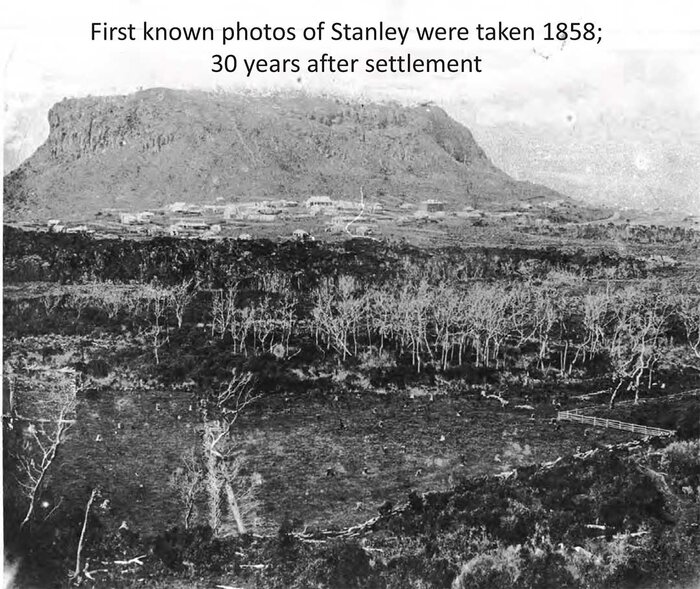
1861 - 1880 Evidence of Prosperity
The valuation rolls for Horton during the period 1861 - 1880 showed the properties owned by John Stagg House. They included -
- 1861, 1870, 1880 -
- Farm 2A, 11,174 acres near Black River Road, owned and occupied by John Stagg House, resident on property
- House at 10 Rougemont Street, Stanley
- 1861 - Occupier of property, John Berjew
- 1870 - Occupier of property, William Harman
- 1880 - House and Smithy - Occupier William Harman
- House at 92 Alexander Terrace, Stanley
- 1861 - Occupier of property, Carrol, Denis Senior
- 1870 - 1880 - Occupier of property, Henry J. Emmett
- House at 29 Fletcher Street, Stanley
- 1861 - Occupier of property, George Halliday
- 1870 - Occupier of property, George Halliday
- 1880 - Occupier of property, Thomas Fraser
- Allotment at 114 Church Street, Stanley
- 1861 - Unoccupied
- 1870 - Occupier of property, Rev. James Holohan
- 1880 - Occupier of property, John Foster
- House at 82 Church Street, Stanley
- 1861 - Occupier of property, Daniel Lynch
- 1870 - 1880 - Occupier of property, John Bidley
- House at 58, 59 Church Street,Stanley
- 1861 - Occupier of property, John Charles McDowell
- 1870 - Occupier of property, Rev. James Holohan
- 1880 - Occupier of property, William Forward
- Farm near Detention River, 200 acres
- 1870 - Occupier of property, John Stagg House
- 1880 - Occupier of property, James Ferguson Boys (son-in-law)
- Allotment, Fletcher Street, Stanley
- 1880 - Occupier of property, Thomas Borradale

1870 - Land Grant of 200 acres to John Stagg House
This the document granting 200 acres of land near Detention River to John Stagg House for the sum of £242/14/6d.
1862 - Meeting of Landholders
In his capacity as Trustee for the Horton Road district, John House was one of landholders who convened a meeting of landholders of Horton on Monday 10th of February, 1862 at 12 o'clock noon at the "Ship Inn" in Stanley, for the election of new Trustees for the said Road District for the purposes of the "Cross and By-Roads Act", 1800. Others landholders who had called for the meeting included - John Alford, Patrick Carroll, Albert Harman Boys,William Medwin, Samuel Horton, George Fann, Michael Lyons, John Williams, and Allen Nunn.
Source : Launceston Examiner, 14 January, 1862
1882 - Last Will and Testament of John Stagg House
John House made his Will just 4 days after the death of his wife, Eliza.
I give and bequeath to my son Jonathan House and to my son Thomas House and to my daughters Hester Carroll House, Elizabeth Boyes, Matilda Eliza Thorp and Annie Marie or to their heirs...one sixth share each of my real and person estate and I direct my Executors as soon as possible after my decease to sell the whole of my ... estate expecting that portion to...credit all monies due to me to divide the same as above directed.And I further direct that upon the termination of the lease of the farm occupied by my son Thomas House and situated in Forest, Circular Head the paid farm shall be sold and the money...with any other monies which may have accrued from rent or otherwise should be equally divided among my aforesaid sons and daughters their heirs...I hereby appoint Harry Griffin Spicer, Joseph Harman and Charles Tasman Ford all of Circular Head my executors..
1885 - Death of John Stagg House
His death was the result of "Paralysis Exhaustion" - which was possibly stroke.
Death has taken from us a very old and highly respected resident,in the person of Mr. John Stagg House, who died on Sunday last, at the advanced age of seventy three.During a long residence, Mr. House has acted the part of a good colonist and kindly neighbour, and he leaves numerous descendants to perpetuate his name, and to emulate, I trust, his upright life.He has been for some years an almost helpless invalid, and death was the result of natural decay. The interment took place this afternoon, and was largely attended by residents representing every portion of the district.Source : Launceston Examiner, 17 January, 1885
1885 - Probate
Probates have been granted in the estates of the following deceased persons:-...John Stagg House to Harry Griffin Spicer £153Estate Valued: did not exceed the sum of £153Source :The Mercury, Tuesday morning, June 9 1885

